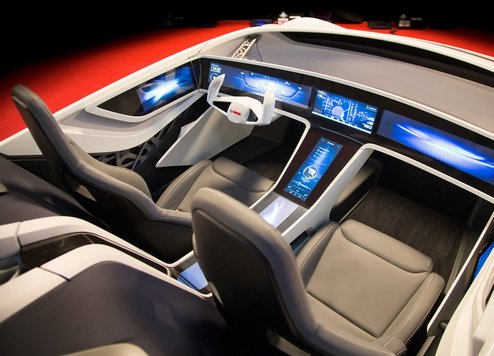 Connected cars need big displays and global revenue from automotive display systems will grow at a compound annual growth rate (CAGR) of more than 11 percent to $18.6 billion by the end of 2021. This will add close to $9 billion in annual revenue compared to 2015, according to IHS Inc.
Connected cars need big displays and global revenue from automotive display systems will grow at a compound annual growth rate (CAGR) of more than 11 percent to $18.6 billion by the end of 2021. This will add close to $9 billion in annual revenue compared to 2015, according to IHS Inc.
Global production volumes for factory-installed center stack and instrument cluster display systems are each estimated to grow by more than 40 percent over the forecast period, each surpassing 60 million units by 2021. IHS forecasts an even higher growth rate for the production of head-up display systems, which will exceed 65 percent, surpassing 6 million units annually in that same timeframe.
Head-up display systems are growing globally, as prices for these new and innovative display technologies fall and they become increasingly relevant to reduce driver distraction.
Center stack display systems are expected to account for half of the overall revenue growth, while head-up display (HUD) systems will boast the strongest revenue CAGR at nearly 21 percent from 2015, note data reported in Automotive Display Forecasts.
The automotive displays supply chain will see some amazing growth and innovation through the end of the decade, as more vehicles debut new displays or standardize larger ones in the instrument cluster, center stack and head-up display systems. There will also be growth opportunity in lower volume display applications for rear seat entertainment, HVAC control panels, and new applications such as smart mirrors with full displays entering the market now.
Automotive displays are increasing in volume and in size. IHS forecasts global shipments for automobile display components overall to grow at a CAGR of more than 6 percent to 170.6 million units by the end of 2021. IHS reports at least two TFT-LCD or AMOLED displays will be in all new cars produced in 2021.
By 2021 automotive displays 7.0-inches and larger are forecasted to reach 33.5 million units. Automotive display sizes are growing quickly to help support multiple infotainment, safety and vehicle system functions that require more screen real estate to inform drivers and passengers.
Increasing demand for infotainment functions, safety systems and vehicle electrification have persuaded OEMs to consider larger, more complex displays in the center stack, instrument cluster and other applications. Global shipments for instrument cluster displays are shifting from 3.0-inch and 4.0-inch to more than 5.0-inches, and center stack displays are shifting to 7.0-inches and larger. Center stack displays between 8.0-inches and 10.0-inches are already common among high-end vehicles and luxury brands, and they are even being introduced in high-volume vehicles, like D-segment sedans and crossovers.
Aftermarket applications for automotive displays also continue to grow, with high demand for aftermarket navigation systems and radios in China, Russia, and Brazil. These numbers also impact global automotive display shipments.
For more information contact IHS. -IHS recenlty announced it has acquired CARPROOF Corporation, a Canada-based company that offers products and services in vehicle history, appraisal and valuation for the automotive industry, for $650 million CND (approximately $460 million USD). More details on the acquisition will be provided on the IHS fourth quarter and year-end 2015 earnings call on January 12, 2016.